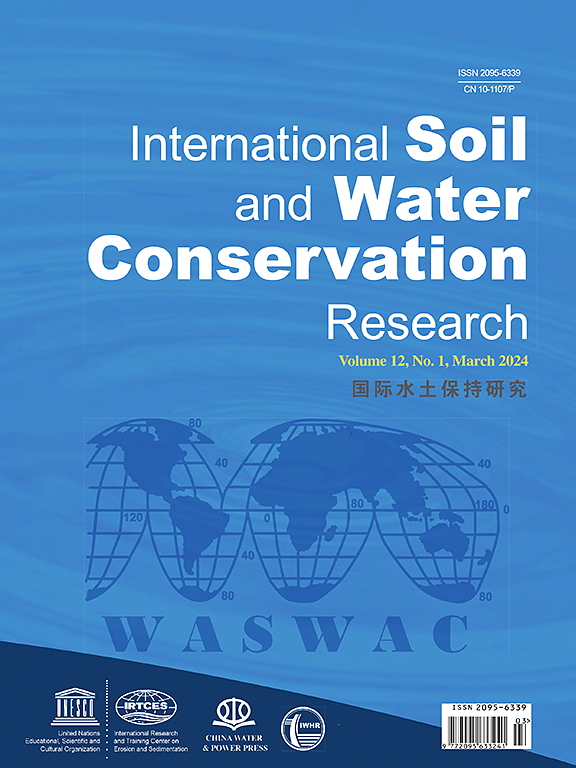How does shrub stem coverage affect the hydraulic properties of concentrated flow and sediment yield during gully bed erosion?
IF 7.3
1区 农林科学
Q1 ENVIRONMENTAL SCIENCES
International Soil and Water Conservation Research
Pub Date : 2025-01-11
DOI:10.1016/j.iswcr.2025.01.002
引用次数: 0
Abstract
Vegetation plays a critical role in influencing runoff processes and soil loss during gully bed erosion. However, it is still unclear how the stem coverage affects gully bed erosion processes by altering the runoff hydraulics and soil sedimentation. A series of in situ scouring experiments were conducted to investigate the influence of shrub stem coverage on the concentrated flow pathway characteristics, hydrodynamic parameters, and sediment concentration during gully bed erosion processes. The Flow pathway characteristics expressed by the Number of flow pathways (FN), total Flow path Width (FW), Tortuosity Ratio (TR), and Fractal Dimension (FD) were quantified by analyzing photographs of the gully bed surface taken during experimental periods. Structural equation model was used to analyze the comprehensive effect of stem coverage on hydraulic erosion of gully beds. The results showed that FN, FW, and TR increased linearly, and FD increased exponentially as stem coverage increased. Compared with the bare gully bed, the flow velocity and shear stress of gully beds with shrub stem covers decreased by 17.47%–25.19% and 4.75%–11.42%, respectively, while the Darcy-Weisbach friction factor increased by 35.94%–68.71%. The sediment concentration of stem-covered gully beds decreased by 11.82%–26.93%. The increasing stem coverage promoted concentrated flow branching and significantly increased FW, which in turn altered hydraulic parameters, particularly reducing flow velocity, and ultimately reducing sediment concentrations indirectly. These results contribute to partially explaining the differences in flow hydraulics and soil loss of vegetated gully beds in previous studies that failed to account for changes in flow pathways.
灌木茎盖度如何影响沟床侵蚀过程中集中水流的水力特性和产沙量?
在沟床侵蚀过程中,植被对径流过程和土壤流失具有重要影响。然而,目前尚不清楚干覆盖如何通过改变径流水力学和土壤沉积来影响沟床侵蚀过程。通过一系列原位冲刷试验,研究了灌丛盖度对沟床侵蚀过程中集中流道特征、水动力参数和泥沙浓度的影响。通过分析实验期间拍摄的沟床表面照片,量化了由流道数(FN)、总流道宽度(FW)、弯度比(TR)和分形维数(FD)表示的流道特征。采用结构方程模型,分析了干盖度对沟床水力侵蚀的综合影响。结果表明:随着茎盖度的增加,FN、FW和TR呈线性增加,FD呈指数增加;与裸沟床相比,有灌木覆盖的沟床流速和剪应力分别降低了17.47% ~ 25.19%和4.75% ~ 11.42%,达西-韦斯巴赫摩擦系数提高了35.94% ~ 68.71%。茎盖沟床的含沙量下降了11.82% ~ 26.93%。增加茎盖度促进了水流集中分支,显著增加了FW,从而改变了水力参数,特别是降低了流速,最终间接降低了含沙量。这些结果有助于部分解释以前的研究中未能考虑到流动路径变化的植被沟槽床的流动水力学和土壤流失的差异。
本文章由计算机程序翻译,如有差异,请以英文原文为准。
求助全文
约1分钟内获得全文
求助全文
来源期刊

International Soil and Water Conservation Research
Agricultural and Biological Sciences-Agronomy and Crop Science
CiteScore
12.00
自引率
3.10%
发文量
171
审稿时长
49 days
期刊介绍:
The International Soil and Water Conservation Research (ISWCR), the official journal of World Association of Soil and Water Conservation (WASWAC) http://www.waswac.org, is a multidisciplinary journal of soil and water conservation research, practice, policy, and perspectives. It aims to disseminate new knowledge and promote the practice of soil and water conservation.
The scope of International Soil and Water Conservation Research includes research, strategies, and technologies for prediction, prevention, and protection of soil and water resources. It deals with identification, characterization, and modeling; dynamic monitoring and evaluation; assessment and management of conservation practice and creation and implementation of quality standards.
Examples of appropriate topical areas include (but are not limited to):
• Conservation models, tools, and technologies
• Conservation agricultural
• Soil health resources, indicators, assessment, and management
• Land degradation
• Sustainable development
• Soil erosion and its control
• Soil erosion processes
• Water resources assessment and management
• Watershed management
• Soil erosion models
• Literature review on topics related soil and water conservation research
 求助内容:
求助内容: 应助结果提醒方式:
应助结果提醒方式:


